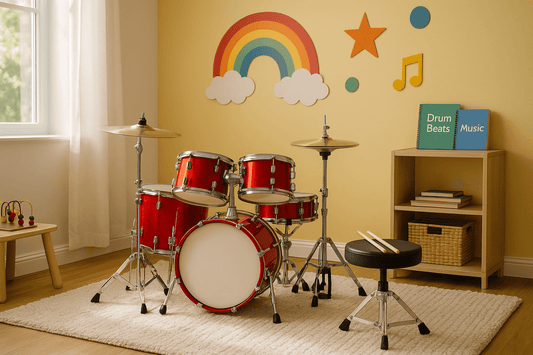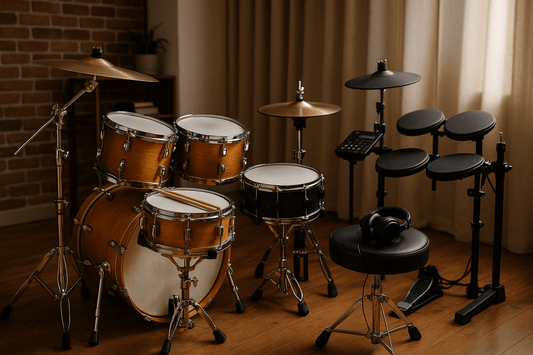Introduction
If you’ve ever seen your toddler banging on pots, pans, or even cardboard boxes with unmatched enthusiasm, you’ve probably wondered—can toddlers actually play drums? The short answer is: absolutely, yes! But the real magic lies in choosing the right kind of kit, setting realistic expectations, and understanding what "playing" means at this early stage of development.
Drumming can be an incredible outlet for energy, creativity, and learning—even for children as young as 18 months. It helps develop rhythm, coordination, listening skills, and even early social-emotional abilities. And as more experts weigh in on the benefits of musical play in early childhood, toddler drum sets are becoming one of the most recommended tools for fun, focused development.
So if you’re considering giving your little one their first kit, this article breaks down what child development specialists, educators, and music teachers have to say. We’ll also highlight one of the most parent-loved options—the 7-Piece Red Toddler Drum Set—which ticks every box for safe, musical fun.
Let’s explore whether toddler drumming is a good idea (spoiler: it is!) and how to make the most of those first rhythmic steps.
Are Toddlers Too Young to Play Drums?
One of the most common concerns parents have is whether their toddler is actually ready for something like a drum kit. After all, we’re talking about little humans who might still be mastering the art of walking or forming full sentences.
Here's what experts say:
Toddlers are in a prime stage of physical and cognitive development, and music can support that growth in powerful ways. According to pediatric occupational therapists and early childhood educators, kids as young as 18 months show natural inclinations toward:
-
Rhythmic play: Repeating beats or patterns
-
Imitation: Copying actions like clapping or tapping
-
Sensory exploration: Responding to sounds and vibrations
What “playing drums” really means at this age:
-
It’s not about keeping perfect time.
-
It’s not about learning songs or music theory.
-
It’s about exploring sound, motion, and rhythm in a safe and enjoyable way.
This is why specially designed toddler drum sets are different from regular beginner kits—they focus more on engagement, fun, and development than on performance.
So no, toddlers aren’t too young. But they do need a kit that matches their stage—more on that in the next section.
Benefits of Drumming for Toddlers
Giving your toddler a drum set might feel like an invitation to chaos, but in reality, you’re giving them a powerful developmental tool. Here's how drumming positively impacts early childhood growth:
🧠 Cognitive Development
-
Repeating rhythms enhances memory and focus
-
Listening and mimicking patterns build sequencing skills
-
Engaging both hands encourages bilateral coordination
💪 Physical Development
-
Improves gross motor skills (arm movements, leg coordination with foot pedals)
-
Builds fine motor control with stick grip and tapping precision
-
Enhances balance and posture as they sit and reach
😊 Emotional and Social Growth
-
Expressing feelings through sound can reduce tantrums
-
Following along with songs promotes patience and attention
-
Playing with parents or siblings boosts social interaction and bonding
🎶 Early Music Education Foundation
-
Prepares them for rhythm-based instruments in the future
-
Helps develop ear training and beat recognition
-
Introduces structure through musical play
Even if your child never becomes a professional drummer, early exposure to musical instruments has been shown to improve language development, self-esteem, and school readiness.
What to Look for in a Drum Set for Toddlers
Now that you’re convinced toddlers can and should play drums, the next step is finding the right kit. A toddler drum set isn’t just a scaled-down version of a real drum kit—it’s designed with safety, simplicity, and play in mind.
✅ Key Features to Look For:
1. Safety First
-
BPA-free, non-toxic materials
-
Rounded edges and smooth surfaces
-
Soft-tipped or lightweight sticks
2. Kid-Friendly Size
-
Miniature drum heads placed at reachable height
-
Stools that fit little legs comfortably
-
No complicated assembly required
3. Simplicity in Layout
-
Look for 3 to 7-piece setups max
-
Too many pieces can overwhelm and clutter the play area
-
Simpler designs allow toddlers to focus on coordination
4. Engaging Features
-
Light-up drums or sounds can boost interactivity
-
Some kits play music or include a microphone for singing
-
Bonus: educational features like rhythm games or demo beats
5. Durability
-
Toddlers can be rough—make sure the kit can handle it!
-
Choose sets with reinforced bases and well-secured drum heads
When in doubt, go for something versatile, colorful, and easy to maintain. Which brings us to our top expert-recommended pick.
Expert-Approved Toddler Drum Set Picks
🥁 Top Choice: 7-Piece Red Toddler Drum Set
This drum set is the gold standard when it comes to toddler-friendly drumming. It combines everything parents want—safety, quality, style—with what toddlers crave: something they can hit, explore, and enjoy.
🌟 Why Experts Recommend It:
-
Sized perfectly for kids aged 2 to 5
-
Lightweight drumsticks for little hands
-
Bright red design grabs attention and encourages use
-
7-piece layout includes bass drum, toms, snare, cymbal, and stool
-
Durable construction withstands heavy toddler play
👪 Why Parents Love It:
-
Easy to assemble in under 15 minutes
-
Great for indoor play without taking over the entire room
-
Affordable price point with long play value
-
Fun gift idea for birthdays or milestones
If your toddler loves music, movement, and making joyful noise, this kit is the ideal gateway into rhythm and creativity.
Electric vs Acoustic: Which is Better for Toddlers?
If you’ve started exploring drum sets, you’ve likely noticed they fall into two main categories: electric and acoustic. But which one is better for toddlers?
Let’s break it down.
🔌 Electric Drum Sets for Toddlers
Electric kits for young children are designed with quiet play and interactive learning in mind.
✅ Pros:
-
Volume Control: Use headphones for silent play
-
Pre-loaded Music: Many models come with songs or rhythm games
-
Smaller Footprint: Compact and perfect for bedrooms or apartments
-
Digital Features: Some sets include lights, songs, and even Bluetooth support
❌ Cons:
-
Can be more expensive upfront
-
Needs batteries or power cords
-
May be overwhelming for tech-shy parents
Electric kits are a great option if you’re dealing with limited space, noise concerns, or want a more structured music experience.
🥁 Acoustic Drum Sets for Toddlers
Traditional toddler drum sets (like the 7-Piece Red Drum Set) offer a more hands-on, natural-feeling way to explore rhythm.
✅ Pros:
-
Real drum response = more tactile feedback
-
No setup or power required
-
Simpler design = easier for toddlers to engage
❌ Cons:
-
Louder (good or bad depending on your setup!)
-
Takes up a bit more space
-
Doesn’t offer learning tools like some electric kits
If your goal is open-ended, freestyle rhythm play, acoustic is the better choice for toddlers. Plus, there’s less that can break or malfunction—always a win with young kids.
How to Introduce Drums to Your Toddler
Drums are exciting! But without a thoughtful introduction, your child might lose interest or treat them like a novelty. Here’s how to make drumming part of their daily rhythm—literally.
🎯 1. Keep It Fun, Not Formal
This isn’t about music school—it’s about joy. Let your toddler hit, tap, and explore freely without pressure to perform.
🧠 2. Model First
Show them how you tap to the beat of a song. Clap, stomp, or use a stick to tap a rhythm and invite them to copy you.
🎵 3. Play Along with Music
Use familiar songs (like nursery rhymes or lullabies) and encourage them to drum along with the beat. This builds timing and musical awareness.
🪇 4. Make Up Games
Try rhythm games like:
-
“Echo me”: You play a pattern, and they repeat it
-
“Stop and go”: Drum when the music plays, stop when it pauses
-
“Find the beat”: Tap to match a song’s rhythm together
📅 5. Create a Routine
Even 5–10 minutes a day can help. Keep the drum kit in a visible, accessible spot to encourage daily play.
What Age is Best to Start Drumming?
Most toddlers can begin interacting with drum sets around 18 months to 2 years old, depending on their interest and coordination.
🧒 Ages 1.5–2
-
Begin with simple, toy-style kits or padded hand drums
-
Focus on cause-and-effect and sensory play
👦 Ages 2–3
-
Introduce small sticks and 3–5 piece kits
-
Encourage copying, clapping, and basic rhythms
👧 Ages 3–5
-
Transition to 7-piece drum kits (like the Red Toddler Drum Set)
-
Begin mimicking songs, playing along, and using both hands/feet
🎯 Pro Tip: Every child is different. If your toddler enjoys rhythm and repetition, they’re probably ready. If not, let them lead the way—music should never be forced.
Drum Safety Tips for Toddlers
Safety matters, especially when sticks and sound are involved! Keep drumming safe and fun with these simple guidelines:
✅ Supervision
Always supervise toddlers when using a drum kit—especially when sticks are involved. Show them how to play safely and discourage hitting anything but the drum set.
✅ Volume Awareness
-
Use drums in short bursts to protect young ears
-
Choose soft-tipped or foam drumsticks
-
Avoid loud metal cymbals until age 5+
✅ Clean-Up & Storage
-
Store sticks out of reach when not in use
-
Keep drums clean with a wipe-down once a week
-
Tighten loose parts to prevent wobble or injury
✅ Avoid Small Parts
Ensure no detachable small pieces (nuts, bolts, toy accessories) are within reach, especially for kids under 3.
When to Encourage Lessons (or Not Yet)
It’s tempting to sign your toddler up for drum lessons the moment they show interest—but is it too soon? Most music educators agree that formal drum lessons are best saved for ages 5 and up, when children have longer attention spans and better motor coordination.
That said, there are signs that your toddler might be ready for structured learning even earlier:
✅ Signs Your Toddler May Be Ready:
-
They copy rhythms accurately
-
They show interest in music for more than 5 minutes at a time
-
They’re excited to “practice” without being asked
-
They recognize song structures or try to sing and drum simultaneously
If your toddler shows these signs, consider enrolling them in music play classes rather than formal drum lessons. These are often rhythm-based group classes designed for ages 2–4 that include:
-
Singing
-
Movement
-
Basic percussion
-
Parent-child musical games
🎯 Tip: Don't rush! Keep it playful. The goal at this stage is to nurture curiosity, not technical proficiency.
Final Thoughts: Let the Beat Begin
So—can toddlers play drums? Absolutely.
In fact, drumming may be one of the best early activities you can introduce. It’s fun, hands-on, and supports nearly every area of early development—from fine motor skills to emotional regulation.
With the right gear—like the 7-Piece Red Toddler Drum Set—your child gets a safe, engaging way to explore music and movement while developing foundational life skills.
Whether they become a future rockstar or just enjoy banging along to The Wiggles in the living room, one thing’s for sure: they’ll be learning, laughing, and growing with every beat.
Let the rhythm roll!
FAQs
1. Is a toddler drum set a good gift?
Yes! A toddler drum set makes a fun and educational gift for birthdays, holidays, or milestones. It promotes physical, cognitive, and emotional development through interactive play.
2. Can a 2-year-old use drumsticks?
Yes, but with supervision. Use soft-tipped or foam sticks to protect hands and furniture. Some toddler sets include sticks made specifically for small hands.
3. Are drum sets safe for toddlers?
As long as you choose age-appropriate kits with no small parts and supervise usage, toddler drum sets are completely safe. Look for non-toxic materials and rounded edges.
4. Will a toddler drum kit be loud?
Acoustic kits will be noisy, but electric toddler drums (or kits with volume control) are quieter. You can also limit playtime or use padded sticks to manage sound.
5. How long will my child use a toddler drum set before upgrading?
Most toddler drum kits are suitable until age 5. After that, you might consider moving up to a junior beginner kit with more components and realistic features.




